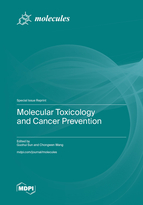Molecular Toxicology and Cancer Prevention
A special issue of Molecules (ISSN 1420-3049). This special issue belongs to the section "Medicinal Chemistry".
Deadline for manuscript submissions: closed (31 August 2023) | Viewed by 22525
Special Issue Editors
Interests: tumor resistance; pharmacology; molecular toxicology; environmental pollutants; computational toxicology
Special Issues, Collections and Topics in MDPI journals
Interests: novel diagnostic technology; biosensors; POCT; SERS; quantum dot
Special Issues, Collections and Topics in MDPI journals
Special Issue Information
Dear Colleagues,
Molecular toxicology is a field that investigates the interaction between chemical molecules and organisms at the molecular level. Chemical molecules, including, but not limited to, environmental pollutants, natural products, synthesized compounds and pharmaceuticals, are closely associated with the development, prevention and treatment of various disease such as cancer. Therefore, the toxic effects and mechanisms of chemical molecules, as well as their applications on cancer diagnosis and imaging, cancer therapeutic methods and anticancer drugs both fall within the scope of the Special Issue. Of course, experimental and theoretical studies (e.g., in silico modelling, computational toxicology, QSAR, artificial intelligence, machine learning and bioinformatics) as well as review articles are all welcome. We encourage scholars worldwide to consider devoting their time to the development of molecular toxicology and cancer prevention. We welcome papers in related fields to contribute to our Special Issue, so as to devote joint efforts in academic development.
Dr. Guohui Sun
Dr. Chongwen Wang
Guest Editors
Manuscript Submission Information
Manuscripts should be submitted online at www.mdpi.com by registering and logging in to this website. Once you are registered, click here to go to the submission form. Manuscripts can be submitted until the deadline. All submissions that pass pre-check are peer-reviewed. Accepted papers will be published continuously in the journal (as soon as accepted) and will be listed together on the special issue website. Research articles, review articles as well as short communications are invited. For planned papers, a title and short abstract (about 100 words) can be sent to the Editorial Office for announcement on this website.
Submitted manuscripts should not have been published previously, nor be under consideration for publication elsewhere (except conference proceedings papers). All manuscripts are thoroughly refereed through a single-blind peer-review process. A guide for authors and other relevant information for submission of manuscripts is available on the Instructions for Authors page. Molecules is an international peer-reviewed open access semimonthly journal published by MDPI.
Please visit the Instructions for Authors page before submitting a manuscript. The Article Processing Charge (APC) for publication in this open access journal is 2700 CHF (Swiss Francs). Submitted papers should be well formatted and use good English. Authors may use MDPI's English editing service prior to publication or during author revisions.
Keywords
- molecular toxicology
- environmental pollutants
- natural products
- synthesized compounds
- carcinogenesis
- cancer treatment
- computational toxicology
- QSAR








